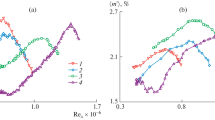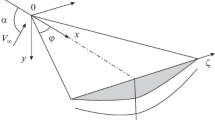Abstract
A study is made of the flow of a viscous compressible gas in a hypersonic shock layer on sweptback wings of infinite span with blunt leading edge at different angles of attack. The equations of the hypersonic viscous shock layer with modified Rankine-Hugoniot relations across the shock wave and boundary conditions on the surface of the body that take into account slip and discontinuity of the temperature are solved by a method of successive approximation which yields not only an analytic solution for the first approximations but also an exact numerical solution when the method is implemented on a computer. The analytic solution of the problem is found in the first approximation. Expressions are obtained for the coefficients of friction and heat transfer on the surface of the body, and also for the profiles of the velocities and the temperature across the shock layer. Comparison of the analytic solution with the numerical solution reveals a satisfactory accuracy of the analytic solution for not too large Reynolds numbers.
Similar content being viewed by others
Literature cited
L. I. Sedov, M. P. Mikhailova, and G. G. Chernyi, “Influence of viscosity and thermal conductivity on gas flow behind a strongly curved shock wave,” Vestn. Mosk. Univ. Ser. Fiz. Mat. Estest. Nauk, No. 3 (1953).
H. K. Cheng, “The blunt-body problem in hypersonic flow at low Reynolds number,” Inst. Aerospace Sci. Paper, No. 92 (1963).
A. L. Ankudinov, “Calculation of a viscous hypersonic shock layer with mass injection at moderately low Reynolds numbers,” Izv. Akad. Nauk SSSR, Mekh. Zhidk. Gaza, No. 3 (1970).
A. L. Ankudinov, “Viscous shock layer around a paraboloid of revolution,” Tr. TsAGI, No. 1448 (1973).
K. M. Magomedov, “Hypersonic flow of a viscous gas over blunt bodies,” Izv. Akad. Nauk SSSR, Mekh. Zhidk. Gaza, No. 2 (1970).
S. W. Kang, “Hypersonic low-Reynolds-number flow over a blunt body with mass injection,” AIAA J.,7, No. 8 (1969).
R. T. Davis, “Numerical solution of the hypersonic viscous shock-layer equations,” AIAA J., 8, No. 5 (1970).
B. N. Srivastava, M. J. Werle, and R. T. Davis, “Stagnation region solutions of the full viscous shock-layer equations,” AIAA J.,14, No. 2 (1976).
I. G. Brykina, “Integration of the equations of a hypersonic viscous shock layer by a method of successive approximation,” Zh. Vychisl. Mat. Mat. Fiz.,18, No. 1 (1978).
É. A. Gershbein, “On the theory of three-dimensional hypersonic flow of a viscous gas over blunt bodies in the presence of blowing,” in: Some Problems in the Mechanics of Continuous Media [in Russian], Izd-vo MGU, Moscow (1978).
G. A. Tirskii, “A method of successive approximation for integration of the equations of the multicomponent laminar boundary layer with chemical reactions, including ionization reactions,” Otchet NII Mekhan. MGU, No. 1016 (1969).
Yu. D. Shevelev, Three-Dimensional Problems of the Theory of the Laminar Boundary Layer [in Russian], Nauka, Moscow (1977).
V. P. Shidlovskii, Introduction to the Dynamics of a Rarefied Gas [in Russian], Nauka, Moscow (1965).
Author information
Authors and Affiliations
Additional information
Translated from Izvestiya Akademii Nauk SSSR, Mekhanika Zhidkosti i Gaza, No. 2, pp. 91–102, March–April, 1979.
We thank G. A. Tirskii for his interest in the work and valuable discussions.
Rights and permissions
About this article
Cite this article
Brykina, I.G., Gershbein, É.A. Hypersonic viscous shock layer on sweptback wings of infinite span at different angles of attack. Fluid Dyn 14, 238–246 (1979). https://doi.org/10.1007/BF01051666
Received:
Issue Date:
DOI: https://doi.org/10.1007/BF01051666




